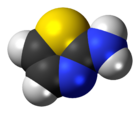Chemistry:Aminothiazole

| |

| |
| Names | |
|---|---|
| Preferred IUPAC name
1,3-Thiazol-2-amine | |
| Other names
2-Thiazolamine, Aminothiazole, 2-Thiazylamine, Basedol, 2-Thiazolylamine, 4-Thiazolin-2-onimine, 2-Amino-1,3-thiazole, Abadole
| |
| Identifiers | |
3D model (JSmol)
|
|
| ChEBI | |
| ChEMBL | |
| ChemSpider | |
| KEGG | |
PubChem CID
|
|
| UNII | |
| |
| |
| Properties | |
| C3H4N2S | |
| Molar mass | 100.14 g·mol−1 |
| Appearance | Light yellow crystals |
| Melting point | 86 to 89 °C (187 to 192 °F; 359 to 362 K) |
| Boiling point | 117 °C (243 °F; 390 K) (20 hPa) |
| 100 g/L (20 °C) | |
| -56.0·10−6 cm3/mol | |
| Hazards | |
| NFPA 704 (fire diamond) | |
| 600 °C (1,112 °F; 873 K) | |
Except where otherwise noted, data are given for materials in their standard state (at 25 °C [77 °F], 100 kPa). | |
| Infobox references | |
2-Aminothiazole is a heterocyclic amine featuring a thiazole core. It can also be considered a cyclic isothiourea. It possesses an odor similar to pyridine and is soluble in water, alcohols and diethyl ether. It is commonly used as a starting point for the synthesis of many compounds including sulfur drugs, biocides, fungicides, dyes and chemical reaction accelerators. 2-Aminothiazole can be used as a thyroid inhibitor in the treatment of hyperthyroidism and has antibacterial activity. Alternatively, its acid tartrate salt can be used. Recent studies using prion-infected neuroblastoma cell lines have suggested that aminothiazole may be used as a therapeutic drug for prion diseases.[1]
Many 2-aminothiazoles and 2-amidothiazoles are drugs: avatrombopag, amthamine, amiphenazole, abafungin, acotiamide, pramipexole.
References
- ↑ Gallardo-Godoy A; Gever J; Fife KL; Silber BM; Prusiner SB; Renslo AR. (Feb 24, 2011). "2-Aminothiazoles as therapeutic leads for prion diseases.". J Med Chem 54 (4): 1010–21. doi:10.1021/jm101250y. PMID 21247166.


